Open BIM Standards: A Review of the Processes for Managing Existing Structures in the Pre- and Post-Earthquake Phases
Abstract
1. Introduction
- Preventative activities: these are carried out in the pre-earthquake period, and aim to guarantee safety during a seismic event and reduce repair costs as much as possible thereafter. As they are conducted in the absence of an emergency and on individual buildings, they are supported by very detailed analytical assessments, which are used to define ad hoc solutions and strategically optimize the resources required;
- Processes to manage damaged buildings: these are carried out in the post-earthquake period, and require very rapid evaluations of a building’s viability, equally fast interventions in the initial emergency phase, and more accurate assessments in the subsequent reconstruction stage.
2. Processes for Managing Existing Structures
2.1. Preventive Activities
- Hazard analysis [13]—quantifying the intensity of potential seismic effects and the site-specific probability that those of a given intensity will occur;
- Structural analysis—predicting a building’s response to earthquake shaking, expressed in the form of response quantities (i.e., demands) that could be associated with structural and non-structural damage;
- Damage analysis—described by probabilistic curves (known as fragility curves) [14]; these identify the probability of a specific level of damage as a function of an Engineering Demand Parameter (EDP) related to seismic actions;
- Loss analysis—economic losses are estimated based on the performance of a structure.
2.2. Post-Seismic Phase
- Rapid evaluation;
- Detailed evaluation;
- Engineering analysis.
- Has been INSPECTED (green placard)—the damage does not pose any significant risk. This is only intended to notify people that the building is safe for occupation; it does not mean that any damage should be ignored or that repairs are unnecessary;
- Is safe for RESTRICTED USE (yellow placard)—this addresses conditions where there are no clear safety concerns, but the damage identified precludes unrestricted occupancy. This notice is used if the evaluation reveals such damage that there should be no entry to part of a building, or where there is a restriction on the use or occupancy of the entire structure;
- Is UNSAFE (red placard)—there is an immediate risk associated with entry, use or occupancy, denoting that going into a building is not permitted for any reason. This does not automatically mean that the property has been condemned or will require demolition.
- A level 1 rapid assessment involves a brief external visual inspection of a building to assess the type and extent of its structural damage;
- A level 2 rapid assessment is still relatively brief but, importantly, requires access to both the interior of a building for more extensive observations, as well any available drawings. This type of evaluation is typically required for all critical facility, multi-story, and other buildings where the level 1 process identifies the need for further and detailed inspections [26];
- Level 3 in-depth engineering evaluations are usually carried out regardless of the outcomes of any level 1 or level 2 rapid assessments.
3. The Role of BIM Models in Pre- and Post-Earthquake Investigations
- Acquiring knowledge of a construction;
- BIM modelling;
- Structural analysis;
- Retrofit intervention planning.
- A critical historical analysis to research documents, reports and available drawings;
- A geometric structural survey to identify the load-bearing elements;
- A mechanical characterization of materials, based on investigational assessments [35].
4. The IDM Standard for Encoding a Structure’s Management Processes
- Where a step fits into the process and why it is relevant;
- The actors involved in creating, utilizing and benefitting from the information produced;
- What the information created and consumed actually is;
- How the information can be supported with software solutions.
Process Map
- Makes information exchanges between a project’s participants more reliable;
- Improves the quality of information;
- Improves decision making;
- Enables a BIM project to be conducted much more effectively.
- Produces better responses to user needs;
- Guarantees the quality of the information exchange;
- Creates reusable software components.
5. Application of the Procedure Using Open BIM Standards in a Case Study of Palazzo Penne
5.1. BIM Modelling and Management
5.2. Implementation of Digital Datasheets for the Collection of Information
- ▪
- AEDES sheets;
- ▪
- Lessico normal 1/88;
- ▪
- Abacus of decays;
- ▪
- “Provisions concerning the post-seismic activity findings resulting from seismic events that affected the territory of the regions of Lazio, Marche, Umbria and Abruzzo on 24 August 2016”, Ordinance No. 10 of 19 December 2016 and s.m.i. (trad. “Disposizioni concernenti i rilievi di agibilità post sismica conseguenti agli eventi sismici che hanno colpito il territorio delle Regioni Lazio, Marche, Umbria e Abruzzo a partire dal giorno 24 agosto 2016”, Ordinanza n. 10 del 19 December 2016 and s.m.i.)
- ▪
- Directive of the Minister of Cultural Heritage, Activities and Tourism—Addition to the Directive of 12 December 2013-“Procedures for the management of activities to make safe and safeguard cultural heritage in the event of emergencies resulting from natural disasters” (trad. Direttiva del Ministro dei beni e delle attività culturali e del turismo—Aggiornamento della direttiva del 12 dicembre 2013—“Procedure per la gestione delle attività di messa in sicurezza e salvaguardia del patrimonio culturale in caso di emergenze derivanti da calamità naturali”.)
6. The Digital Maturity of the Processes for Managing Existing Structures
7. Conclusions
Author Contributions
Funding
Conflicts of Interest
References
- Welch, D.P.; Sullivan, T.J.; Filiatrault, A. Potential of Building Information Modelling for seismic risk mitigation in buildings. Bull. N. Z. Soc. Earthq. Eng. 2014, 47, 253–263. [Google Scholar] [CrossRef]
- Maio, R.; Santos, C.; Ferreira, T.M.; Vicente, R. Investigation Techniques for the Seismic Response Assessment of Buildings Located in Historical Centers. Int. J. Arch. Herit. 2018, 12, 1245–1258. [Google Scholar] [CrossRef]
- Ma, L.; Sacks, R.; Zeibak-Shini, R. Information modeling of earthquake-damaged reinforced concrete structures. Adv. Eng. Inform. 2015, 29, 396–407. [Google Scholar] [CrossRef]
- Garavaglia, E.; Anzani, A.; Maroldi, F.; Vanerio, F. Non-Invasive Identification of Vulnerability Elements in Existing Buildings and Their Visualization in the BIM Model for Better Project Management: The Case Study of Cuccagna Farmhouse. Appl. Sci. 2020, 10, 2119. [Google Scholar] [CrossRef]
- Christodoulou, S.E.; Vamvatsikos, D.; Georgiou, C.A. BIM-Based Framework for Forecasting and Visualizing Seismic Damage, Cost and Time to Repair. In eWork and eBusiness in Architecture, Engineering and Construction; Scherer, R.M., Ed.; Taylor & Francis Group: London, UK, 2010; pp. 33–38. ISBN 978-0-415-60507-6. Available online: https://ktisis.cut.ac.cy/handle/10488/14303 (accessed on 3 November 2020).
- Xu, Z.; Lu, X.; Zeng, X.; Xu, Y.; Li, Y. Seismic loss assessment for buildings with various-LOD BIM data. Adv. Eng. Inform. 2019, 39, 112–126. [Google Scholar] [CrossRef]
- Mellado, F.; Wong, P.F.; Amano, K.; Johnson, C.; Lou, E.C. Digitisation of existing buildings to support building assessment schemes: Viability of automated sustainability-led design scan-to-BIM process. Arch. Eng. Des. Manag. 2019, 16, 84–99. [Google Scholar] [CrossRef]
- Godinho, M.; Machete, R.; Ponte, M.; Falcão, A.P.; Gonçalves, A.B.; Bento, R. BIM as a resource in heritage management: An application for the National Palace of Sintra, Portugal. J. Cult. Herit. 2020, 43, 153–162. [Google Scholar] [CrossRef]
- Patacas, J.; Dawood, N.; Kassem, M. BIM for facilities management: A framework and a common data environment using open standards. Autom. Constr. 2020, 120, 103366. [Google Scholar] [CrossRef]
- Calvi, G.M.; Pinho, R.; Magenes, G.; Bommer, J.J.; Restrepo-Vélez, L.F.; Crowley, H. Development of seismic vulnerability assessment methodologies over the past 30 years. ISET J. Earthq. Technol. 2006, 43, 75–104. [Google Scholar]
- Filiatrault, A.; Lee, G.; Aref, A.; Bruneau, M.; Constantinou, M.C.; Reinhorn, A.M.; Whittaker, A. Recent progress towards the seismic control of structural and non-structural systems in hospitals. In Proceedings of the US-Japan 36th Technical Meeting of Panel on Wind and Seismic Effects, Washington, DC, USA, 17–22 May 2004. [Google Scholar]
- FEMA-P58. Seismic Performance Assessment of Buildings—Volume 1: Methodology; Federal Emergency Management Agency: Washington, DC, USA, 2008. [Google Scholar]
- McGuire, R.K. Probabilistic seismic hazard analysis: Early history. Earthq. Eng. Struct. Dyn. 2008, 37, 329–338. [Google Scholar] [CrossRef]
- Shinozuka, M.; Feng, M.Q.; Lee, J.; Naganuma, T. Statistical Analysis of Fragility Curves. J. Eng. Mech. 2000, 126, 1224–1231. [Google Scholar] [CrossRef]
- Melani, A.; Khare, R.; Dhakal, R.; Mander, J.B. Seismic risk assessment of low rise RC frame structure. Structures 2016, 5, 13–22. [Google Scholar] [CrossRef]
- Cardone, D.; Flora, A. Direct displacement loss assessment of existing RC buildings pre- and post-seismic retrofitting: A case study. Soil Dyn. Earthq. Eng. 2014, 64, 38–49. [Google Scholar] [CrossRef]
- Cardone, D.; Perrone, G. Damage and Loss Assessment of Pre-70 RC Frame Buildings with FEMA P-58. J. Earthq. Eng. 2016, 21, 23–61. [Google Scholar] [CrossRef]
- Bothara, J.; Mander, J.B.; Dhakal, R.P.; Khare, R. Seismic performance and financial risk of masonry house. ISET J. Earthq. Technol. 2007, 421–444. Available online: https://ir.canterbury.ac.nz/handle/10092/4442 (accessed on 3 November 2020).
- Solberg, K.M.; Dhakal, R.P.; Mander, J.B.; Bradley, B.A. Computational and rapid expected annual loss estimation methodologies for structures. Earthq. Eng. Struct. Dyn. 2007, 37, 81–101. [Google Scholar] [CrossRef]
- European Commission. Urgent Provisions for the Transposition of Directive 2010/31/EU of the European Parliament and of the Council of 19 May 2010 on the Energy Performance of Buildings for the Definition of Infringement Procedures Initiated by the European Commission, as Well as Other Provisions on Social Cohesion (Trad. “Disposizioni Urgenti per il Recepimento della Direttiva 2010/31/UE del Parlamento Europeo e del Consiglio del 19 Maggio 2010, Sulla Prestazione Energetica Nell’edilizia per la Definizione delle Procedure D’infrazione avviate dalla Commissione Europea, Nonche’ Altre Disposizioni in Materia di Coesione Sociale”); European Commission: Brussels, Belgium, 2010; D.L. 63/2013 e ss.mm.ii. (s.d.). [Google Scholar]
- Perrone, G.; Cardone, D.; O’Reilly, G.J.; Sullivan, T.J. Developing a Direct Approach for Estimating Expected Annual Losses of Italian Buildings. J. Earthq. Eng. 2019, 1–32. [Google Scholar] [CrossRef]
- Sullivan, T. Use of Limit State Loss versus Intensity Models for Simplified Estimation of Expected Annual Loss. J. Earthq. Eng. 2016, 20, 954–974. [Google Scholar] [CrossRef]
- Vitiello, U.; Ciotta, V.; Salzano, A.; Asprone, D.; Manfredi, G.; Cosenza, E. BIM-based approach for the cost-optimization of seismic retrofit strategies on existing buildings. Autom. Constr. 2019, 98, 90–101. [Google Scholar] [CrossRef]
- Cardone, D.; Sullivan, T.; Gesualdi, G.; Perrone, G. Simplified estimation of the expected annual loss of reinforced concrete buildings. Earthq. Eng. Struct. Dyn. 2017. [Google Scholar] [CrossRef]
- Rojahn, C. Procedures for Post-Earthquake Safety Evaluation of Buildings; Applied Technology Council (ATC): Redwood City, CA, USA, 1989. [Google Scholar]
- Galloway, B.D.; Hare, H.J. A Review of Post-Earthquake Building Control Policies with Respect to the Recovery of the Christchurch CBD; Annual Bulletin of the New Zealand Society for Earthquake Engineering (NZSEE): Christchurch, New Zealand, 2012; pp. 105–116. [Google Scholar]
- Marquis, F.; Kim, J.J.; Elwood, K.J.; Chang, S.E. Understanding post-earthquake decisions on multi-storey concrete buildings in Christchurch, New Zealand. Bull. Earthq. Eng. 2015, 15, 731–758. [Google Scholar] [CrossRef]
- Marshall, J.D.; Jaiswal, K.; Gould, N.C.; Turner, F.; Lizundia, B.; Barnes, J.C. Post-Earthquake Building Safety Inspection: Lessons from the Canterbury, New Zealand, Earthquakes. Earthq. Spectra 2013, 29, 1091–1107. [Google Scholar] [CrossRef]
- Goretti, A.; Di Pasquale, G. An Overview of Post-Earthquake Damage Assessment in Italy; EERI: Pasadena, CA, USA, 2002. [Google Scholar]
- Grunthal, G. Cahiers du Centre Européen de Géodynamique et de Séismologie. European Macroseismic Scale; European Center for Geodynamics and Seismology: Luxembourg, 1998. [Google Scholar]
- Dolce, M.; Goretti, A. Building damage assessment after the 2009 Abruzzi earthquake. Bull. Earthq. Eng. 2015, 13, 2241–2264. [Google Scholar] [CrossRef]
- Sisti, R.; Di Ludovico, M.; Borri, A.; Prota, A. Damage assessment and the effectiveness of prevention: The response of ordinary unreinforced masonry buildings in Norcia during the Central Italy 2016–2017 seismic sequence. Bull. Earthq. Eng. 2018, 17, 5609–5629. [Google Scholar] [CrossRef]
- Ma, L.; Sacks, R.; Zeibak-Shini, R.; Aryal, A.; Filin, S. Preparation of Synthetic As-Damaged Models for Post-Earthquake BIM Reconstruction Research. J. Comput. Civ. Eng. 2016, 30, 04015032. [Google Scholar] [CrossRef]
- Eurocode 8-3—Design of Structures for Earthquake Resistance—Assessment and Retrofitting of Buildings. Available online: https://en.wikipedia.org/wiki/Eurocode_8:_Design_of_structures_for_earthquake_resistance (accessed on 6 November 2020).
- Honic, M.; Kovacic, I.; Sibenik, G.; Rechberger, H. Data-and stakeholder management framework for the implementation of BIM-based Material Passports. J. Build. Eng. 2019, 23, 341–350. [Google Scholar] [CrossRef]
- buildingSMART International. Available online: https://www.buildingsmart.org/standards/bsi-standards/information-delivery-manual/ (accessed on 3 November 2020).
- ISO 29481-1:2016. Building Information Models—Information Delivery Manual—Part 1: Methodology and Format. 2016. Available online: https://www.iso.org/standard/60553.html (accessed on 6 November 2020).
- Wix, J.; Karlshøj, J. Information delivery manual: Guide to components and development methods. buildingSMART Int. 2010, 5, 10. [Google Scholar]
- ISO 16739-1:2018. Industry Foundation Classes (IFC) for Data Sharing in the Construction and Facility Management Industries—Part 1: Data Schema; ISO: Geneva, Switzerland, 2018. [Google Scholar]
- Venugopal, M.; Eastman, C.; Sacks, R.; Teizer, J. Semantics of model views for information exchanges using the industry foundation class schema. Adv. Eng. Inform. 2012, 26, 411–428. [Google Scholar] [CrossRef]
- Voss, E.; Jin, Q.; Overend, M. A BPMN-based process map for the design and construction of façades. J. Facade Des. Eng. 2013, 1, 17–29. [Google Scholar] [CrossRef]
- Lee, Y.-C.; Eastman, C.M.; Solihin, W. An ontology-based approach for developing data exchange requirements and model views of building information modeling. Adv. Eng. Inform. 2016, 30, 354–367. [Google Scholar] [CrossRef]
- Wu, W.; Issa, R. Integrated process mapping for BIM implementation in green building project delivery. In Proceedings of the 13th International Conference on Construction Applications of Virtual Reality, London, UK, 30–31 October 2013; pp. 30–39. [Google Scholar]
- Tsai, Y.-H.; Hsieh, S.-H. Process modeling of a BIM-enabled construction inspection approach with BPMN. In Proceedings of the International Conference on Innovative Production and Construction, Darwin, Australia, 3–5 October 2016. [Google Scholar]
- Wohed, P.; van der Aalst, W.M.P.; Dumas, M.; ter Hofstede, A.H.; Russell, N. On the Suitability of BPMN for Business Process Modelling. In Proceedings of the International Conference on Business Process Management, Vienna, Austria, 4–7 September 2006; Springer: Berlin, Germany, 2006; pp. 161–176. [Google Scholar] [CrossRef]
- Chinosi, M.; Trombetta, A. Modeling and Validating BPMN Diagrams; IEEE: Vienna, Austria, 2009; pp. 353–360. [Google Scholar] [CrossRef]
- Dong, L.; Shan, J. A comprehensive review of earthquake-induced building damage detection with remote sensing techniques. ISPRS J. Photogramm. Remote Sens. 2013, 84, 85–99. [Google Scholar] [CrossRef]
- Şen, Z. Rapid visual earthquake hazard evaluation of existing buildings by fuzzy logic modeling. Expert Syst. Appl. 2010, 37, 5653–5660. [Google Scholar] [CrossRef]
- Jain, S.K. Multi Temporal Image Fusion of Earthquake Satellite Images. Int. J. Adv. Res. Comput. Sci. 2012, 3, 251–255. [Google Scholar]
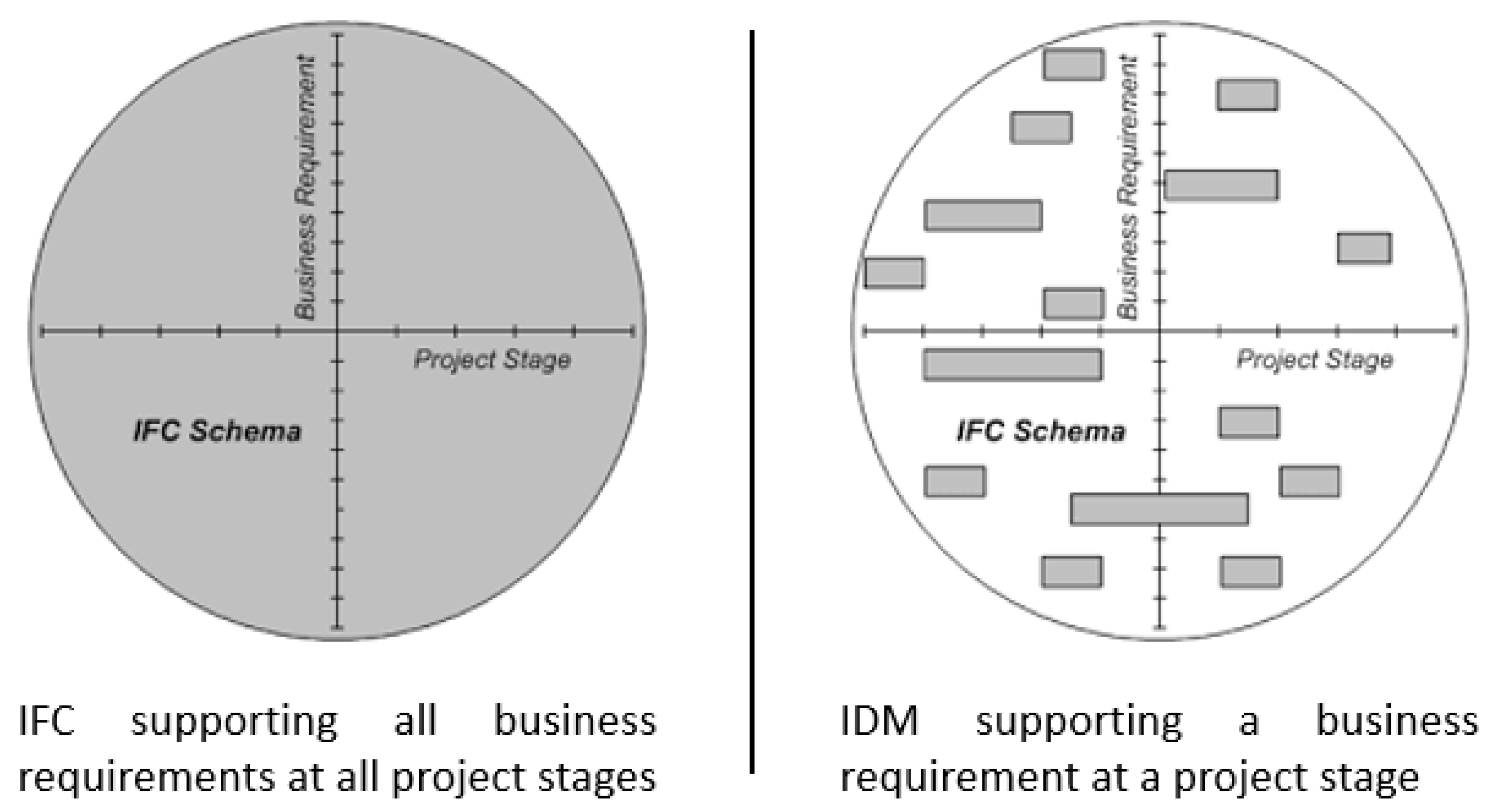
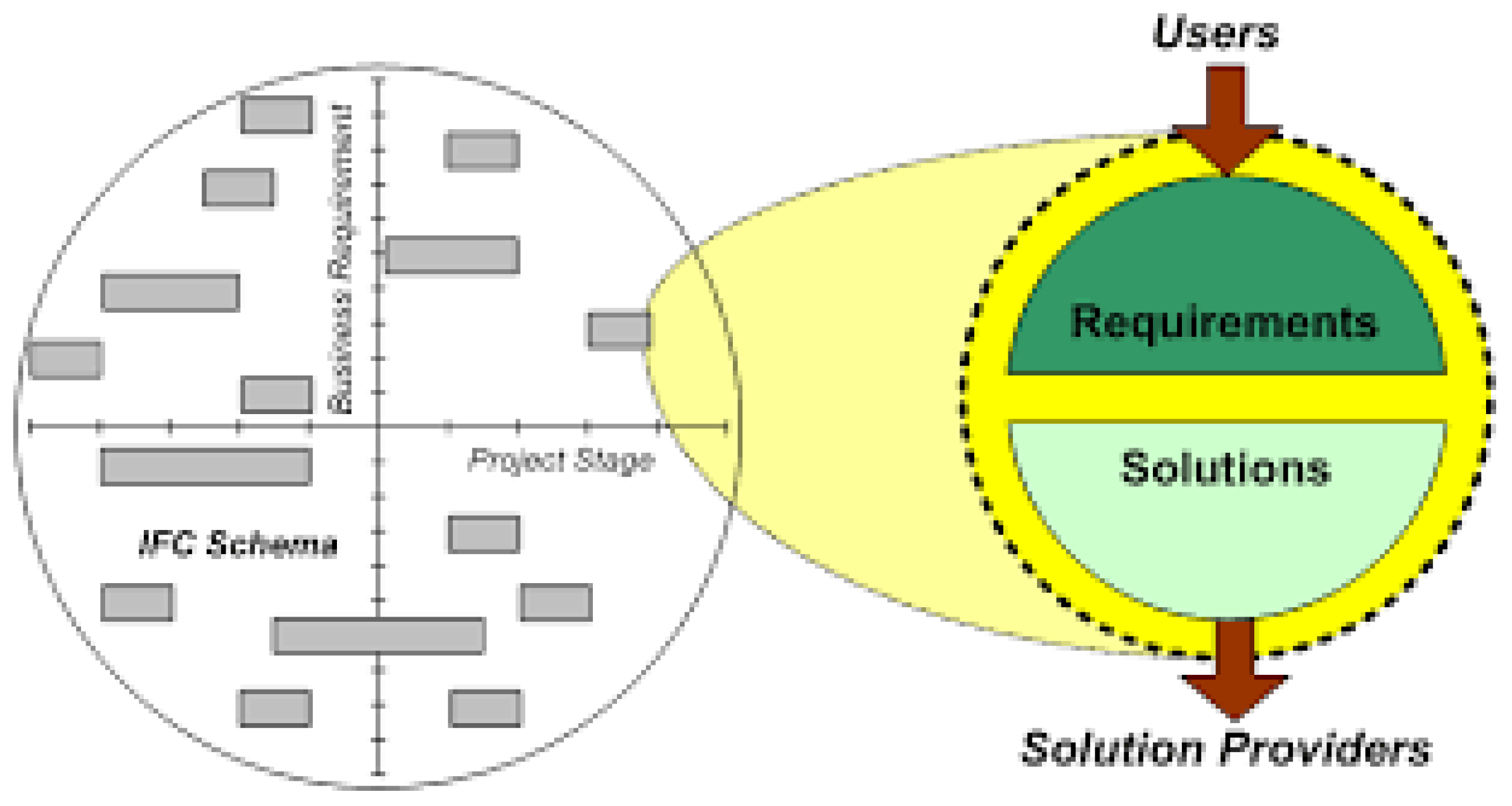
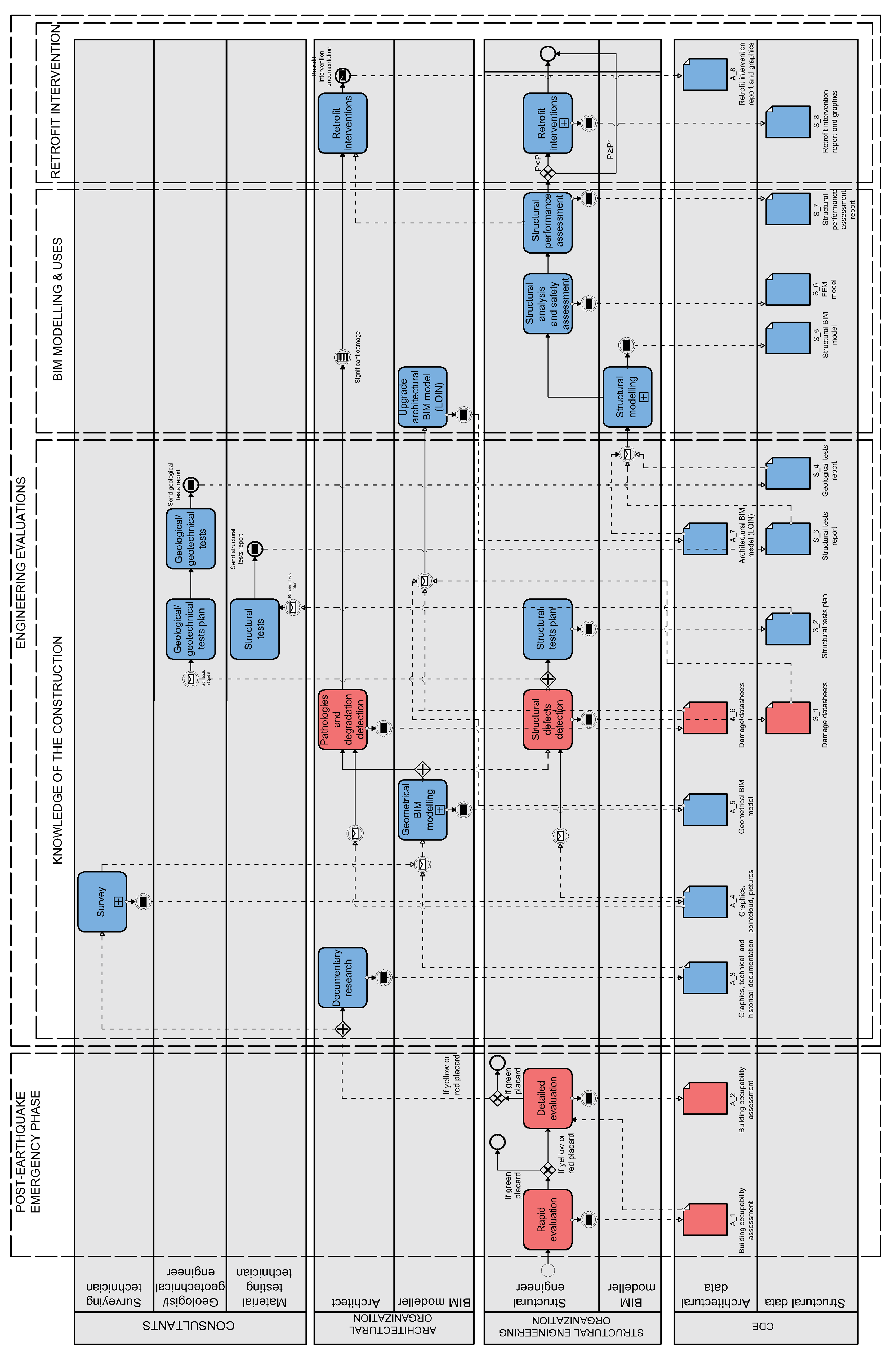

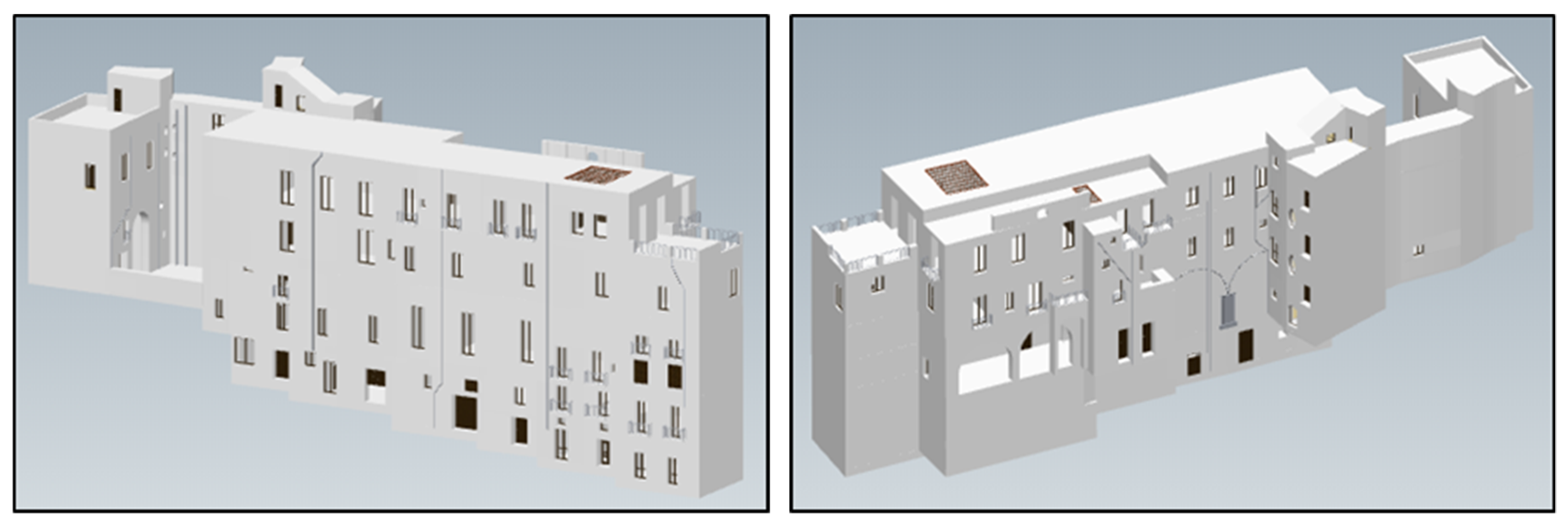
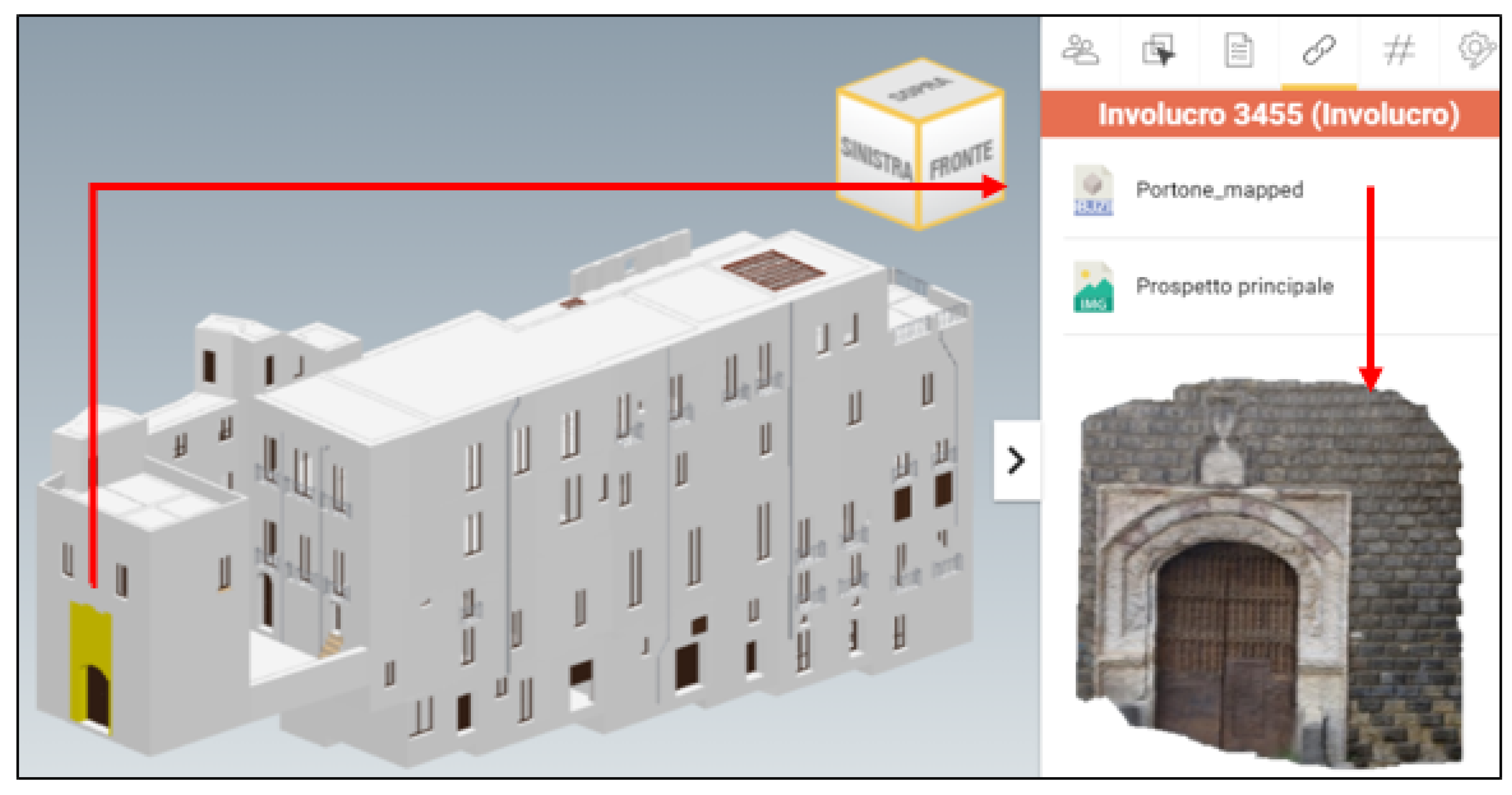
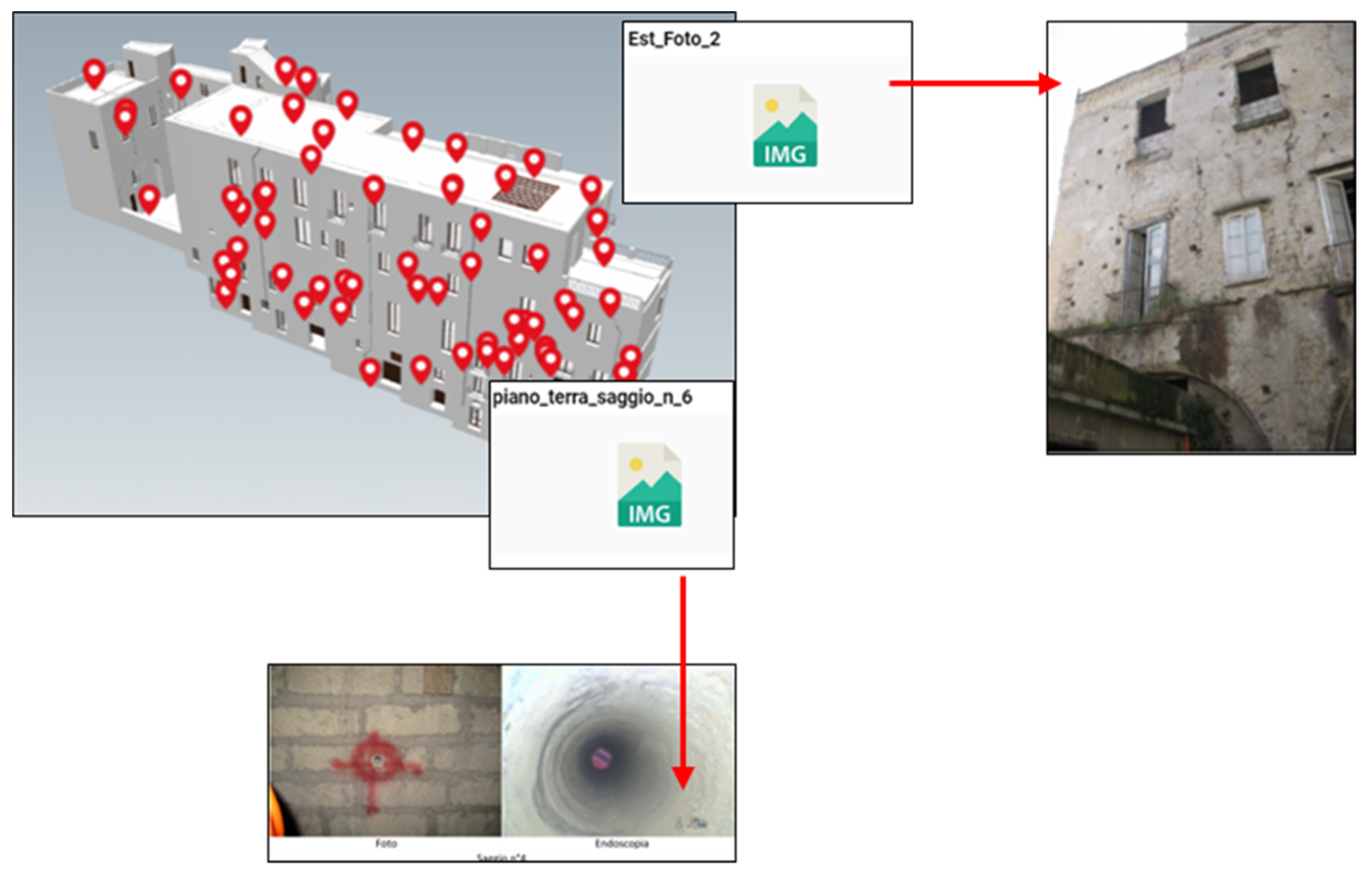
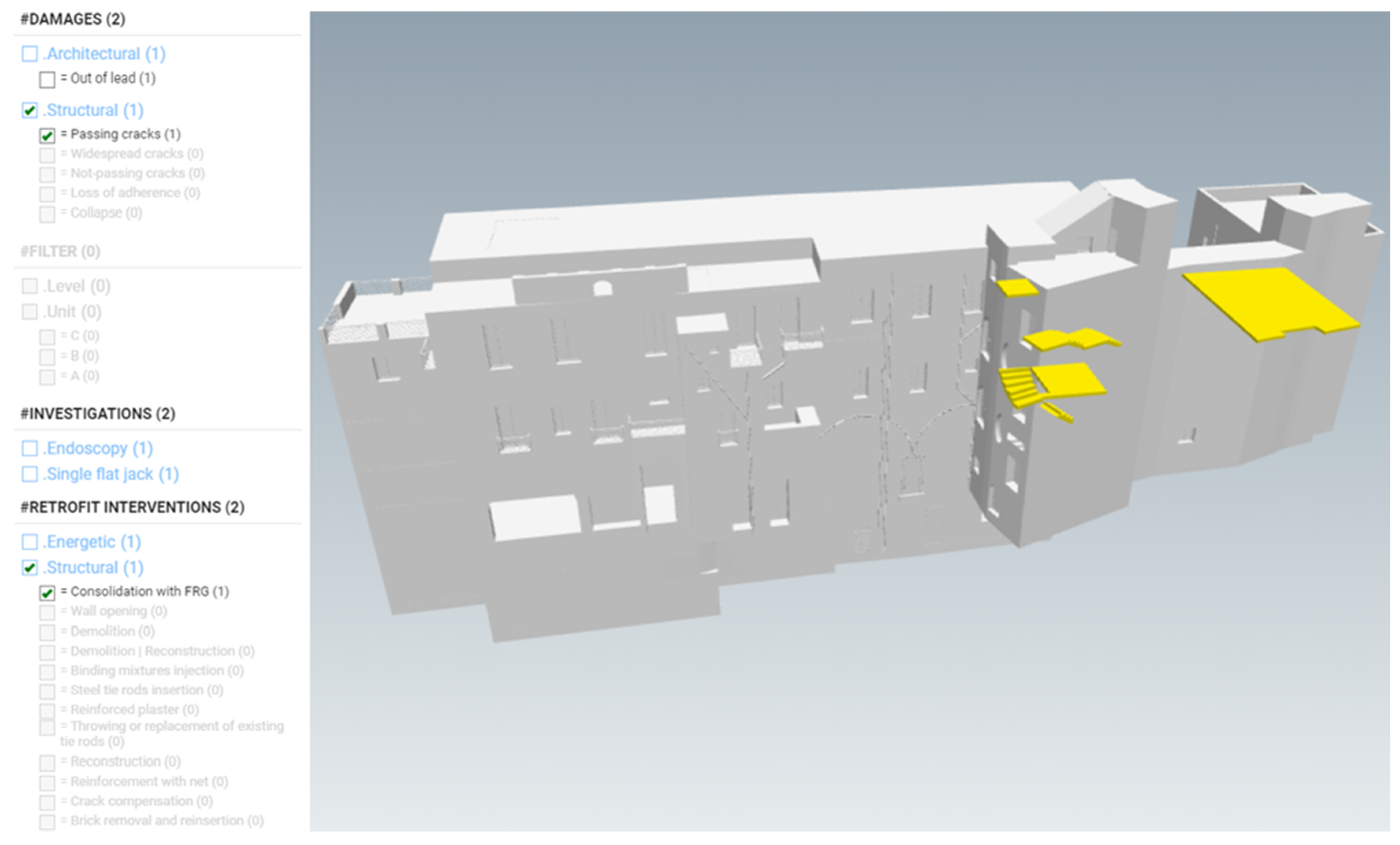
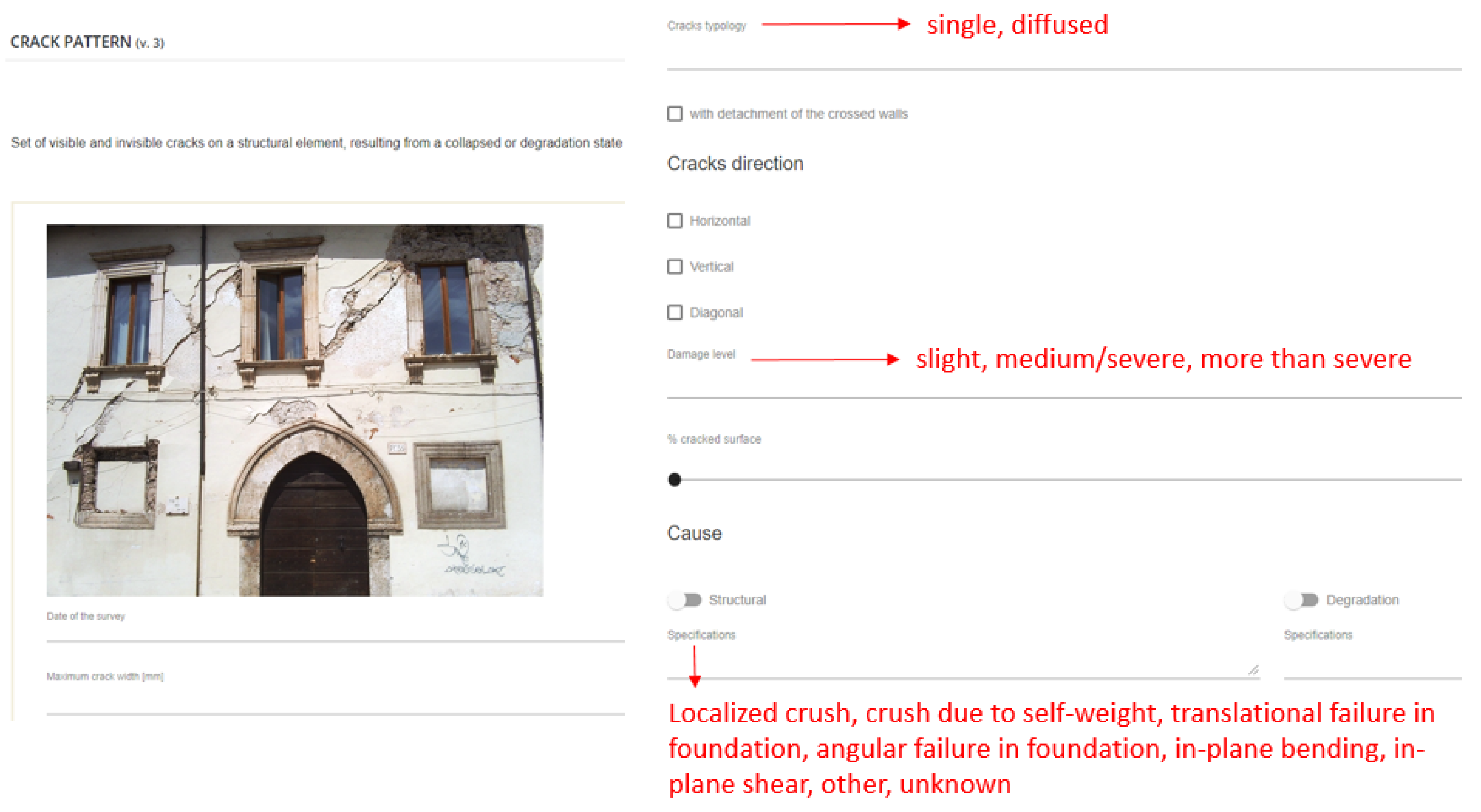
| Phase | Activity | Description | Role |
|---|---|---|---|
| Knowledge of the construction | Document research | Researching documents, graphics and pictures | Structural engineer and architect |
| Survey | Survey of a building’s geometry | Surveying technician | |
| Geometrical BIM modelling | Geometrical BIM modelling using the information previously obtained | Architectural BIM modeller | |
| Structural, geological and geotechnical investigations | On-site and/or laboratory material testing for the mechanical evaluation of materials | Geologist, geotechnical engineer and material-testing technician | |
| Degradation and damage detection | Detection of the damage, if any, affecting the structural elements | Structural engineer and architect | |
| BIM modelling | Architectural BIM modelling | Upgrading the architectural model | Architectural BIM modeller |
| Structural BIM modelling | Structural modelling | Structural BIM modeller | |
| Clash detection | Checking the accuracy of the model | BIM coordinator | |
| Structural analysis | Vulnerability and EAL assessment | Evaluation of the structural performance of a building’s current state | Structural engineer |
| Retrofit intervention planning | Retrofit intervention | Definition of any intervention strategy required to improve the structural performance | Structural engineer and architect |
| Phase | Activity | Description | Role |
|---|---|---|---|
| Emergency | Rapid evaluations | Rapid visual check of the structure, noting the damage extent and severity for an accessibility assessment of the building | Structural engineer |
| Detailed evaluations | Detailed visual check of the structure, noting the damage extent and severity for an accessibility assessment of the building | Structural engineer | |
| Engineering evaluations | Knowledge of the construction | Document research, on-site surveys and material testing | Structural engineer and architect |
| Damage detection | Detection of collapsed elements and the extension and severity of the crack pattern | Structural engineer | |
| Architectural BIM modelling | Architectural BIM modelling of the building and its damage | Architectural BIM modeller | |
| Structural BIM modelling | Structural modelling | Structural BIM modeller | |
| Structural analysis and retrofit interventions | Definition of the intervention strategy needed to make the structure safe | Structural engineer and architect |
Publisher’s Note: MDPI stays neutral with regard to jurisdictional claims in published maps and institutional affiliations. |
© 2020 by the authors. Licensee MDPI, Basel, Switzerland. This article is an open access article distributed under the terms and conditions of the Creative Commons Attribution (CC BY) license (http://creativecommons.org/licenses/by/4.0/).
Share and Cite
Musella, C.; Serra, M.; Salzano, A.; Menna, C.; Asprone, D. Open BIM Standards: A Review of the Processes for Managing Existing Structures in the Pre- and Post-Earthquake Phases. CivilEng 2020, 1, 291-309. https://doi.org/10.3390/civileng1030019
Musella C, Serra M, Salzano A, Menna C, Asprone D. Open BIM Standards: A Review of the Processes for Managing Existing Structures in the Pre- and Post-Earthquake Phases. CivilEng. 2020; 1(3):291-309. https://doi.org/10.3390/civileng1030019
Chicago/Turabian StyleMusella, Christian, Milena Serra, Antonio Salzano, Costantino Menna, and Domenico Asprone. 2020. "Open BIM Standards: A Review of the Processes for Managing Existing Structures in the Pre- and Post-Earthquake Phases" CivilEng 1, no. 3: 291-309. https://doi.org/10.3390/civileng1030019
APA StyleMusella, C., Serra, M., Salzano, A., Menna, C., & Asprone, D. (2020). Open BIM Standards: A Review of the Processes for Managing Existing Structures in the Pre- and Post-Earthquake Phases. CivilEng, 1(3), 291-309. https://doi.org/10.3390/civileng1030019






